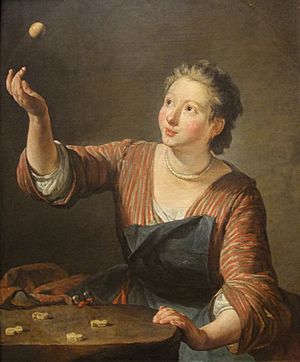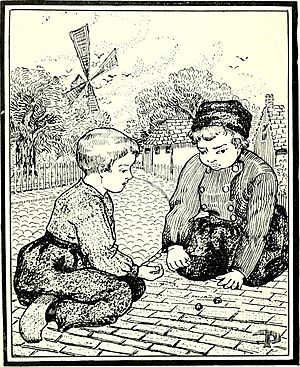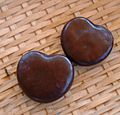Jackstones facts for kids
Knucklebones, also called jacks or five-stones, is a very old game. It's thought to be one of the first games ever played, possibly coming from Asia. It might even be an early version of dice!
The game is played with five small objects. Long ago, people used real "knucklebones" from sheep. These were bones from the animal's ankle. Today, knucklebones are usually made of metal or plastic. The goal is to be the first player to finish a set series of throws. These throws can be different depending on where you play. A simple way to play is to toss one stone, called the "jack," into the air. While it's in the air, you quickly pick up other stones from the ground. You keep going until you've picked up all five stones. Another way is to toss one stone, then two, then three, and so on. You then catch them on the back of your hand. Each type of throw often has its own special name.
There are a few basic rules to follow:
- If you touch any stones you weren't supposed to, you're out.
- If you don't catch the stone you threw in the air, you're out.
- If you don't catch all the stones from the back of your hand, you're out.
When a player is out, it's the next person's turn to play.
Contents
How to Play Knucklebones Today
Modern knucklebones games involve a series of challenges. Here are some common ways to play:
Basic Throws
- Overhand Throws: First, you "jockey" (toss one stone up and catch it). Then, you throw one stone up and quickly pick up others from the ground. You catch the first stone you threw. You repeat this until all stones are picked up. You can sweep the knucklebones before picking them up.
- Scatter Throws: You scatter all five knucklebones on the ground. Pick one up, throw it in the air, and without sweeping, pick up others. Then catch the one you threw.
- Dumps: Hold all five knucklebones in your hand and drop them in a pile. Carefully pick one stone away without moving any others. Throw this stone up, pick up the other four, and then catch the first one.
Special Catches and Moves
- Clicks: This is like "Overhand Throws," but when you catch the stone you threw, the knucklebones in your hand must make a clicking sound.
- No Click: The opposite of "Clicks." The knucklebones must not make a sound when you catch them.
- Little Jingles: After you "jockey," you keep all the stones you catch in your hand. You don't put any down.
- Big Jingles: Similar to "Little Jingles," but you throw all the stones you have in your hand into the air each time.
- Juggles: After you "jockey," if you catch, say, two stones, you throw three into the air. While they are up, you pick up another stone. You throw that second stone up, then catch the first, then catch the second. You keep going until all the stones are done.
Creative Challenges
- Horse in the Stable: First, "jockey." Then, place your hand on the ground with your fingers making four arches. If you catch two stones while jockeying, put one in the "stable" (under your hand). Throw the other stone up. While it's in the air, sweep another stone through one of the arches into the stable. You can sweep as many times as needed. Get all four stones into the stable, each through a different arch. Finally, take your hand away, throw the fifth stone up, pick up the four from the stable, and catch the fifth.
- Through the Arch: Like "Horse in the Stable," but you only make one arch with your thumb and pointer finger. You can only sweep once to get each stone through.
- Over the Line: "Jockey" first. Place your left hand flat on the ground. Put all the stones you caught, except one, on the left side of your hand. Throw your one stone up. While it's in the air, quickly move a stone from the right side of your hand to the left side. Do this until all four stones are on the left side. Try to keep them together. No sweeping is allowed. Once all four are on the left, throw the fifth stone up, pick up the other four, and catch the fifth.
- Over the Jump: This is like "Over the Line," but you stand your hand up on its edge. This makes it harder!
- Thread the Needle: Similar to the above, but you drop the stones through a circle made by your thumb and pointer finger. This circle is held about 8 inches (20 cm) from the ground. Once all stones have gone through, you pick them up.
- Eggs in the Basket: Your hand is cupped, palm up, to form a "basket." The stones must be placed into the "basket" without making a clicking sound. A click means you "broke the eggs."
- Catching Flies: This is like "scatter ones," but you catch the stone with a quick, downward snatching movement. This is much harder than catching with your palms facing up.
Images for kids
-
A collection of jacks at The Children's Museum of Indianapolis
-
An ancient stone carving showing people playing knucklebones from Carchemish (around 8th century BC)
-
Modern plastic gonggi pebbles from South Korea
-
Children in Nepal playing a game similar to knucklebones
See also
 In Spanish: Juego de las tabas para niños
In Spanish: Juego de las tabas para niños










